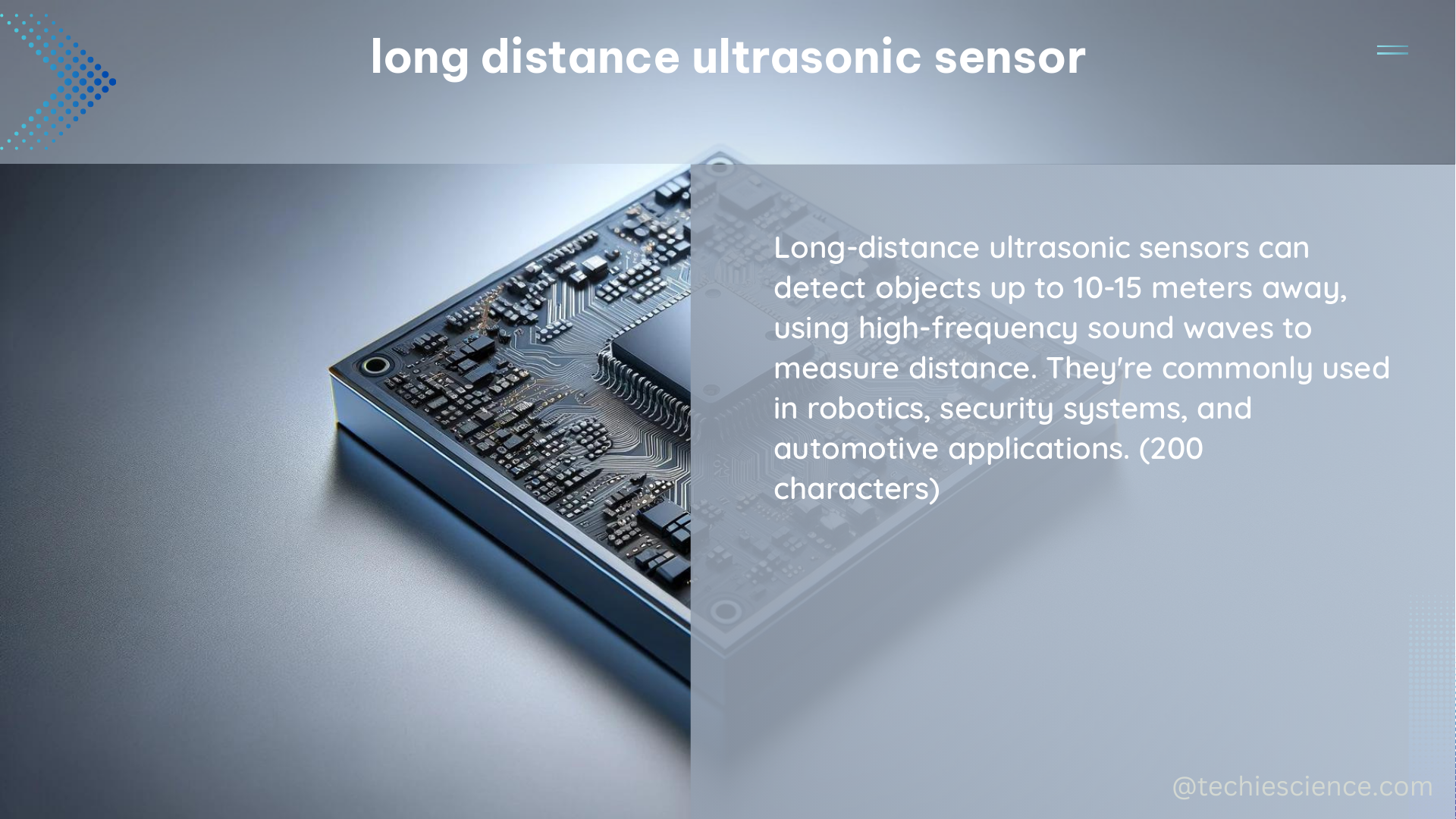Long distance ultrasonic sensors are a powerful tool for precise distance measurement, often used in industrial and scientific applications. These sensors work by emitting high-frequency sound waves and measuring the time it takes for the waves to bounce back after hitting an object. By using the speed of sound in air, which is approximately 343 meters per second, the distance to the object can be calculated based on the time delay.
Understanding the Basics of Long Distance Ultrasonic Sensors
Long distance ultrasonic sensors typically operate at frequencies of 40 kHz or higher, with maximum ranges varying by sensor model, but often reaching several meters. The minimum range is usually a few centimeters, and the resolution can be as precise as a few millimeters. Accuracy is typically within a few percent of the maximum range, making these sensors suitable for a wide range of applications.
The output signal from a long distance ultrasonic sensor can be either analog voltage or digital pulse, and the power supply requirements are typically 5V or 12V DC. The interface is usually TTL or RS-232, allowing for easy integration with microcontrollers and other electronic systems.
Exploring the HC-SR04 Ultrasonic Sensor

One of the most popular long distance ultrasonic sensors is the HC-SR04, which has a maximum range of around 4 meters. This sensor has two key pins: the trigger pin and the echo pin. The trigger pin is used to initiate a measurement by setting it HIGH for at least 10 microseconds, and the echo pin outputs a HIGH signal for a duration proportional to the distance to the object.
To calculate the distance, the duration of the echo signal can be measured using the pulseIn() function in Arduino. This function returns the duration in microseconds, which can then be converted to centimeters by dividing by 29.155 (the time in microseconds per centimeter). Here’s an example Arduino code snippet:
const int trigPin = 9;
const int echoPin = 10;
void setup() {
pinMode(trigPin, OUTPUT);
pinMode(echoPin, INPUT);
Serial.begin(9600);
}
void loop() {
digitalWrite(trigPin, LOW);
delayMicroseconds(2);
digitalWrite(trigPin, HIGH);
delayMicroseconds(10);
digitalWrite(trigPin, LOW);
long duration = pulseIn(echoPin, HIGH);
float distance = duration * 0.034 / 2;
Serial.print("Distance: ");
Serial.println(distance);
delay(1000);
}
It’s important to note that the speed of sound can vary with temperature, humidity, and air pressure, so for very precise measurements, it may be necessary to correct for these environmental factors.
Exploring Other Long Distance Ultrasonic Sensors
In addition to the HC-SR04, there are several other long distance ultrasonic sensors available on the market, each with its own unique features and specifications:
| Sensor | Maximum Range | Accuracy | Interface |
|---|---|---|---|
| MaxBotix LV-MaxSonar-EZ | 7 meters | ±1 cm | Analog, Digital |
| Parallax PING))) Ultrasonic Rangefinder | 3 meters | ±1 cm | Digital |
| Devantech SRF05 | 4 meters | ±3 mm | Digital |
These sensors offer a range of options in terms of maximum range, accuracy, and interface, allowing you to choose the best fit for your specific application.
Building a Long Distance Ultrasonic Sensor from Scratch
If you’re interested in building a long distance ultrasonic sensor from scratch, you’ll need the following components:
- Ultrasonic transducer (e.g., Murata MA40B2S)
- Amplifier circuit (e.g., LM386)
- Microcontroller (e.g., Arduino)
- Power supply (e.g., batteries)
- Wiring and connectors
The basic steps for building a long distance ultrasonic sensor are:
- Connect the ultrasonic transducer to the amplifier circuit, following the manufacturer’s instructions.
- Connect the amplifier circuit to the microcontroller, using the appropriate input and output pins.
- Write the software to control the sensor and read the distance data.
- Test and calibrate the sensor, adjusting the software as necessary.
- Mount the sensor in a suitable housing and connect the power supply.
There are many online resources and tutorials available for building long distance ultrasonic sensors, including detailed instructions and schematics. By understanding the technical specifications and following the proper steps, you can create a custom long distance ultrasonic sensor tailored to your specific needs.
Conclusion
Long distance ultrasonic sensors are a versatile and powerful tool for precise distance measurement, with a wide range of applications in industrial, scientific, and robotic fields. By understanding the underlying principles, exploring different sensor options, and even building your own sensor from scratch, you can unlock the full potential of these remarkable devices.
References
- HC-SR04 Ultrasonic Sensor Datasheet: https://www.waveshare.com/w/upload/b/b9/HC-SR04.pdf
- MaxBotix LV-MaxSonar-EZ User Guide: https://www.maxbotix.com/documents/LV-MaxSonar-EZ_User_Guide.pdf
- Arduino Ultrasonic Sensor Tutorial: https://www.arduino.cc/en/Tutorial/Ping

The lambdageeks.com Core SME Team is a group of experienced subject matter experts from diverse scientific and technical fields including Physics, Chemistry, Technology,Electronics & Electrical Engineering, Automotive, Mechanical Engineering. Our team collaborates to create high-quality, well-researched articles on a wide range of science and technology topics for the lambdageeks.com website.
All Our Senior SME are having more than 7 Years of experience in the respective fields . They are either Working Industry Professionals or assocaited With different Universities. Refer Our Authors Page to get to know About our Core SMEs.